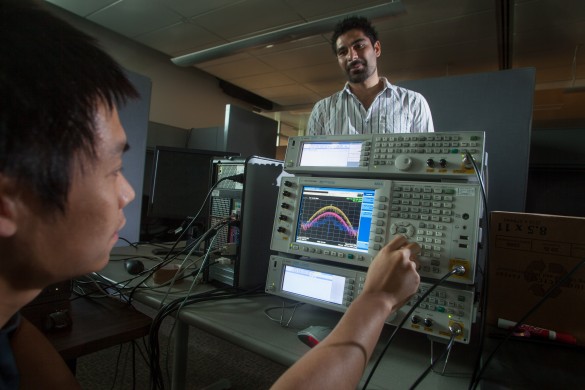Doubling the efficiency of wireless networks to cope with increasing data traffic
November 14, 2012

Graduate students Yiming Ma and Ali Cagatay Cirik work with vector signal generators and a vector signal analyzer (credit: Peter Phun)
Two professors at the University of California, Riverside Bourns College of Engineering have developed a new method that doubles the efficiency of wireless networks and could have a large impact on the mobile Internet and wireless industries.
Efficiency of wireless networks is key because there is a limited amount of spectrum to transmit voice, text and Internet services, such as streaming video and music. And when spectrum does become available it can fetch billions of dollars at auction.
The “spectrum crunch” is quickly being accelerated as customers convert from traditional cell phones to smartphones and tablets. For example, tablets generate 121 times more traffic than a traditional cell phone.
Without making networks more efficient, customers are likely to drop more calls, pay more money for service, endure slower data speed, and not see an unlimited data plan again.
Solution: full-duplex radios
Current radios for wireless communications are half-duplex, meaning signals are transmitted and received in two separate channels. Full-duplex radios transmit and receive signals at the same time in the same frequency band, and can double the efficiency of the spectrum.
However, to make a full duplex radio, one must solve a problem: interference between the transmission and receiving functions. The technology of full-duplex radio is not yet ready for the current 3G and 4G networks. The interference caused by signals from cell towers could be billions times more powerful than the ones towers are trying to pick up from a user’s smartphone. As a result, incoming signals would get drowned out.
Time-domain transmit beamforming
The UC Riverside researchers have found a new solution called “time-domain transmit beamforming,” which digitally creates a self-interference cancellation signal that allows the radio to hear much weaker incoming signals while transmitting strong outgoing signals at the same frequency and same time.
“We believe the future applications of full duplex radios are huge, ranging from cell towers, backhaul networks and wireless regional area networks to billions handheld devices for data intensive application such as FaceTime,” said Liang, who added that the researchers have had discussions with several major wireless telecommunication equipment companies.
Liang and Hua believe their research has commercial potential in part because most of the core components required are digital and work with current chips, so costly new components won’t need to be added to existing infrastructure.
Liang and Hua also believe cell towers are one of the most likely places to start implementing full-duplex radios, in large part because they are less constrained by existing standards.
Liang and Hua also see applications in cognitive radio, a type of wireless communication in which a transceiver can detect which communication channels are in use and which are not, and move into vacant channels while avoiding occupied ones. While cellular frequency bands are overloaded, other bands, such as military, amateur radio and TV, are often underutilized.